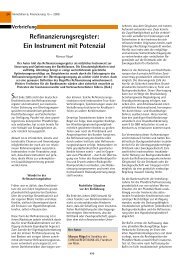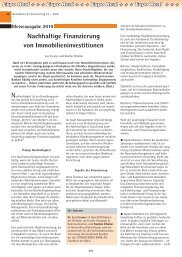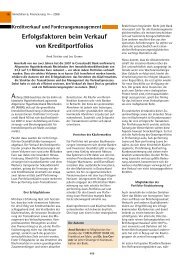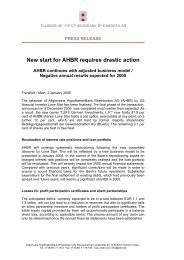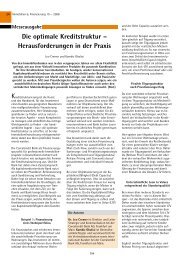COREALCREDIT BANK AG
COREALCREDIT BANK AG
COREALCREDIT BANK AG
Create successful ePaper yourself
Turn your PDF publications into a flip-book with our unique Google optimized e-Paper software.
problems, i.e. the risk that the government of a state may take measures that restrict the crossborder<br />
transfer of capital and/or the procurement of currency; Country risk also includes the risk of<br />
the default or deterioration in credit standing of a country; (iii) Collateral risk is the risk of a<br />
deterioration in the value of collateral for reasons attributable to the property that is being financed,<br />
and/or changes in the relevant market; (iv) Settlement risk is the risk that, following delivery or<br />
payment by the Issuer, the counterparty fails to make the agreed counter-performance; and (v)<br />
Issuer risk is the risk of partial or total loss of receivables from investment securities such as profitshare<br />
rights or other bonds due to the default of the Issuer.<br />
On the part of <strong>COREALCREDIT</strong>, a credit risk exists to an especially high degree, however, in<br />
connection with the granting of credits, since, if this risk is realized, not only is the compensation<br />
for the activity lost, but also and above all the loans which have been made available to the<br />
customer. The Issuer believes that adequate provision has been made for all of<br />
<strong>COREALCREDIT</strong>'s recognized potentially or acutely endangered credit commitments. It cannot be<br />
excluded, however, that <strong>COREALCREDIT</strong> will have to make further provision for possible loan<br />
losses or realize further loan losses, possibly as a consequence of the persistently weak economic<br />
situation, the continuing deterioration in the financial situation of borrowers from <strong>COREALCREDIT</strong>,<br />
the increase in corporate and private insolvencies (particularly in Germany), the decline in the<br />
value of collateral, the impossibility in some cases of realizing collateral values or a change in the<br />
provisioning and risk-management requirements. This may materially adversely affect<br />
<strong>COREALCREDIT</strong>'s net assets, financial position and earnings performance.<br />
Market Risk<br />
Market risk is related to the risk of a loss due to the volatility of market prices of financial<br />
instruments. It includes among others the risk of potential loss arising by changes in market<br />
conditions, i.e. interest rate risk, credit spread risk and exchange-rate risk, or parameters which<br />
influence prices (volatilities, correlations).<br />
Volatility in interest rates, for instance, may negatively affect the Issuer's net interest income and<br />
have other adverse consequences. As with any bank, changes in market interest rates could affect<br />
the interest rates the Issuer charges on its interest-earning assets differently than the interest rates<br />
it pays on its interestbearing liabilities. This difference could result in an increase in interest<br />
expense relative to interest income, which would reduce the Issuer's net interest income, the<br />
largest source of its revenues. An increase in interest rates may reduce the demand for loans and<br />
the Issuer's ability to originate loans. A decrease in the general level of interest rates may affect<br />
the Issuer through, among other things, increased prepayments on its loan portfolio and increased<br />
competition for deposits. Likewise, a decrease in interest rates may affect the Issuer's ability to<br />
securitise parts of its balance sheet positions or otherwise issue debt securities. Interest rates are<br />
highly sensitive to many factors beyond the Issuer's control, including monetary policies and<br />
domestic and international economic and political conditions.<br />
Liquidity Risk and Market Liquidity Risk<br />
The Issuer is exposed to liquidity risk, i.e. the risk that the Issuer is unable to meet its current and<br />
future payment commitments, or is unable to meet them on time (solvency or funding risk). In<br />
addition, the risk exists for the Issuer that inadequate market liquidity will prevent the Issuer from<br />
selling trading positions at short notice or hedging them, or that it can only dispose of them at a<br />
lower price (market-liquidity risk).<br />
Liquidity risk can arise in various forms. It may happen that on a given day the Issuer is unable to<br />
meet its payment commitments and then has to procure liquidity at short notice in the market on<br />
expensive conditions.<br />
33






